While some commentators and journalists have dismissed Occupy Wall Street as carnival, lawmakers and police officers did not miss the point. They reached back to a mid-nineteenth century ban on masking to arrest occupiers wearing as little as a folded bandana on the forehead, leaving little doubt about their fear of Carnival as a potent form of political protest. New York Times journalist Ginia Bellafante initially expressed skepticism about “air[ing] societal grievance as carnival,” but just a few days later she warned against “criminalizing costume,” thus changing her condescension to caution as she confirmed the police’s point: masking can be dangerous, Carnival is serious business.1
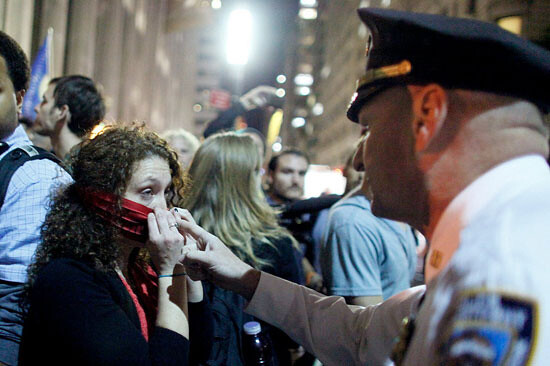

The mask ban was enacted in 1845 to prevent Hudson Valley tenant farmers from resisting eviction by rioting in “Indian” dress and “calico gowns and leather masks.”2 The arrests at OWS on charges of “loitering and wearing a mask” occurred on September 21, the fourth day of the movement’s occupation of Zuccotti Park. The eventual eviction from Zuccotti Park happened two days short of the movement’s two-month anniversary and planned Day of Action known as “N17.” As Kira Akerman noted,
There is almost something comical in occupiers being evicted from Zuccotti Park by the police force in the middle of the night, much in the same way Native peoples were surprised in their tents and pushed off their land …This time white people with Mohawks and brown boots with Indigenous-inspired tassels are banging pots and pans.3
Carnival hardly exists in the United States anymore. It has survived as a Shrovetide festival with Mardi Gras in New Orleans and as a summer celebration for the West Indian community with the Labor Day parade in Brooklyn. However, the carnivalesque—as a medium of emancipation and a catalyst for civil disobedience—is alive and well, and these contemporary carnivals have retained their rebellious potential.
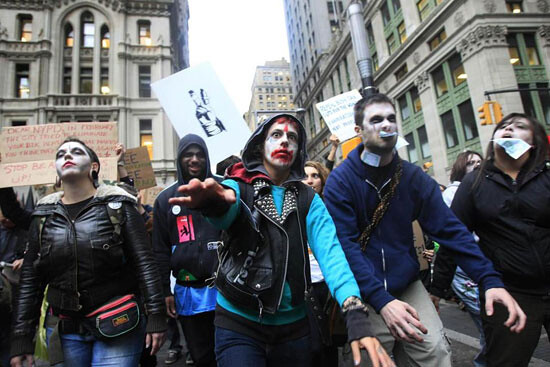

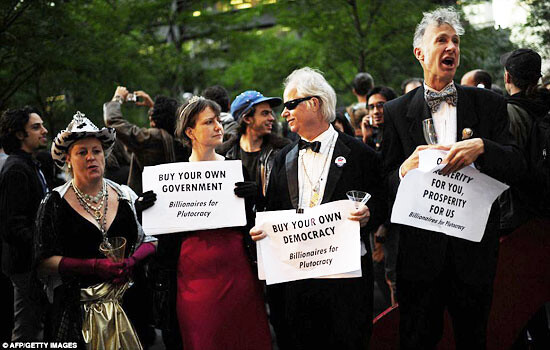

Then there were the countless examples of personal ingenuity. In the early days of the movement, a helmeted woman in fur boots and a figure skating outfit was seen riding a gold and pink papier mâché unicorn. In another case, a young man dressed up as what might be called a Zorro Graduate. He wore the black mask and gloves of the TV avenger, along with a black graduation hat and gown. He held a convict’s chain and iron ball printed with the words “student loan” and a sign reading “Unemployed Superhero, Master of Degrees, Shackled by Debt.”
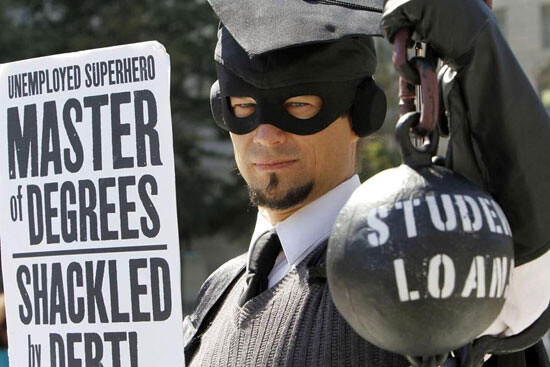

Artists have also answered the call to action. Peter Rostovsky and Lynn Sullivan organized The Language Experiment with about twenty other artists who came together under the name Build the Occupation. First performed on Halloween and then reiterated on N17, the group dressed in orange pie charts and 99% glasses. They held signs (at first handwritten, then printed with a font designed by Steve Robinson) bearing words in the fashion of refrigerator magnet poetry, with reference to Daniel Martinez’s Whitney Biennial piece “I can’t ever imagine wanting to be white” (1993).4 Taken together, the performers formed living sentences, the written equivalent of the “human microphone,” the occupiers’ signature voice amplification technique. These occupation builders delivered collective messages that were permutable at will, if within the range of a carefully chosen consciousness-raising vocabulary.
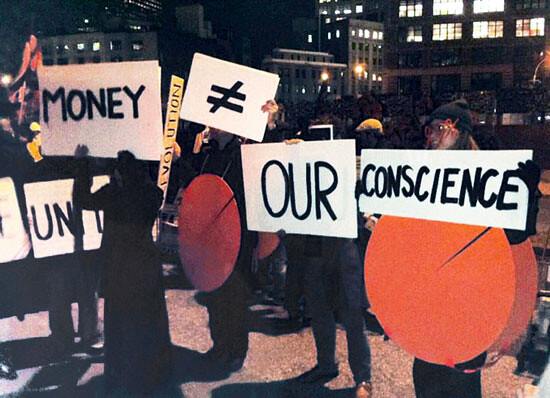

Yet the most poignant message might have been the simplest, exemplifying the merit of “less is more” (however un-carnivalesque that may sound). The photograph of a young blond man, his mouth taped closed by a dollar bill with “#occupy” handwritten on it, has become iconic of the movement. Or maybe it’s because of the American flag tucked in his backpack, putting the whole scene into context.
Still more minimalist, baring it all had been a strategy of (un)masking at Liberty Plaza, as long as the weather allowed. In a corporate world where the clothes make the man, with men in suits (aka the 1%) protected by the blue shirts (regular police officers) and the white shirts (the commanding officers of pepper-spraying fame) from the occupiers (aka the 99%), the spectacle of nudity is a good reminder of the common human nature of the 100%.5
However, we shouldn’t see Carnival merely for the costumes. OWS might well be another Carnival Against Capital—a tactical re-territorialization of public space and political discourse, of social formation and cultural production, carried out as a concerted effort to regain democratic rights and liberties.
“Occupationist International”: Carnival and Anarchism
In fact, carnivalesque protests were a staple of the anti-corporate globalization movement. The Global Carnival Against Capitalism (or “J18”), organized by the activist group Reclaim the Streets, was an international subversive street party that took place on June 18, 1999 to coincide with a G8 summit in Cologne. It updated Mikhail Bakhtin’s characterization of Carnival as a topsy-turvy world where laughter subverts authority.
Bakhtin’s Rabelais and His World, a study of folk culture in the work of French Renaissance writer Rabelais, was written in 1940 but not published in Bakhtin’s native Russia until 1965 due to its veiled critique of Stalin’s purges. The American and French publications of the book (in 1968 and 1970, respectively) gave European and North American anarchists an anti-hierarchical societal model that appealed to their revolutionary aspirations. But it was French situationist Raoul Vaneigem, in his book The Revolution of Everyday Life (1967)6, who fueled the May 1968 student movement with what could be called Carnival liberation theory. Presciently, Vaneigem wrote that “a strike for higher wages or a rowdy demonstration can awaken the carnival spirit,” and “revolutionary moments are carnivals in which the individual life celebrates its unification with a regenerated society.”
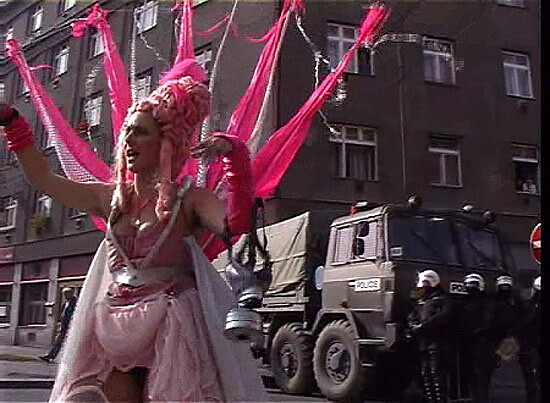

What seems to prevail in the American incarnation of the Occupy movement is a softer latter-day anarchism inherited from the commune movement of the 1960s and the intentional communities of the 1980s. The latter were themselves indebted to the Situationist International and the Italian autonomist movement, and were compounded in American anarchist Hakim Bey’s Temporary Autonomous Zone (TAZ), the tactical field manual of alter-globalization activists since 1985.
While the word “carnival” is not to be found in TAZ, “occupy” is. Bey writes, “Because the State is concerned primarily with Simulation rather than substance, the TAZ can ‘occupy’ these areas clandestinely and carry on its festal purposes for quite a while in relative peace.” This statement aptly summarizes the pre-eviction situation at Liberty Plaza, with an emphasis on “relative peace” given the treatment of occupiers by the NYPD, and a de-emphasis on “clandestine” occupation given the media coverage the movement has garnered.7 However, only one report to date (in the New York Observer) has explicitly linked OWS and TAZ.8
A link that has been more widely made has been between OWS and The Coming Insurrection (2009), a pamphlet written by The Invisible Committee, a French insurrectionary anarchist group. Glenn Beck has hysterically attacked The Coming Insurrection, indicting it as the inspiration for OWS and the international upheavals that preceded it, from the Greek protests of 2010–11 to the UK student movement of 2010 and the Arab Spring. (The latter was first acknowledged as a source of inspiration by the occupiers themselves). The pamphlet proclaims that “we live under an occupation, a police occupation,” and states that “we don’t want to occupy the territory, we want to be the territory,” thereby reversing the rhetoric of occupation (as in the (Un)Occupy Albuquerque movement). It casts a pessimistic light on a state of de facto capitalist colonization of the world.9 Since the eviction of OWS and other encampments, the need to de-territorialize the occupationist strategy and “be the territory” has never seemed more urgent.
The Invisible Committee can be seen as the latest link in “the theoretical lineage … constructed in retrospect [by international activists] to serve the interest of [the] contemporary radical project,” as Gavin Grindon has put it. Grindon initially identifies Bakhtin, Vaneigem, and Bey as part of this lineage.10 However, what one might call the “Occupationist International” freely borrows from the anarchist toolbox, using Bakhtin’s therapeutic laughter, resurrecting Vaneigem’s insurrectional ardor, and implementing Bey’s guerilla tactics, while at the same time rejecting The Invisible Committee’s exhortation to abolish general assemblies. General assemblies have been one of the core characteristics of OWS, introduced by Spanish activists involved in the M15 movement.
Breaking from this anarchist lineage is former French Resistance fighter and concentration camp survivor Stéphane Hessel. His pamphlet Time for Outrage, published in French as Indignez-vous! in 2010 and translated into English by The Nation in early 2011, has been credited as a source for the Spanish movement, where protesters were referred to as “los indignados,” and now for the American movement, where occupiers are referred to as “les indignés” by the French media.11
But David Graeber—the anarchist, activist, and professor of anthropology who was called the “anti-leader” of OWS by Bloomberg Business Week, and who wrote cogently of the movement’s aim as “recapturing the radical imagination”—has a singular manifesto of his own.12 His Debt: The First 5,000 Years (2011), a sprawling history of debt and its economic and cultural implications, might well be this generation’s treatise of savoir-vivre (to borrow from Vaneigem’s original French title), leaving the Canadian anti-consumerist magazine Adbusters, which this summer sent out the call to occupy Wall Street, to do the branding.13
For, in addition to indicting financiers directly, as in the “People’s Trial” of Goldman Sachs on November 3, OWS also targets the financial system as a whole. Thus, it brought renewed momentum to the Move Your Money campaign, whose latest initiative was Bank Transfer Day on November 5. This gives credence to the notion that OWS is not so much waging an economic war as it is waging a war against the economy, possibly one of the most anarchist statements imaginable in a state of corporate occupation.14
Carnival, Capitalism, and Slavery
Just as the economy is the crux of the movement’s concerns, it is also at the core of Carnival. The few contemporary commentators who try to establish a link between—to borrow Grindon’s categories—“carnivalesque attacks upon a shared popular culture” and “carnival as part of a shared popular culture,” usually look to Europe for models of Carnival. But the carnivals of the Americas provide both explanations for and alternatives to this country’s economic plight.
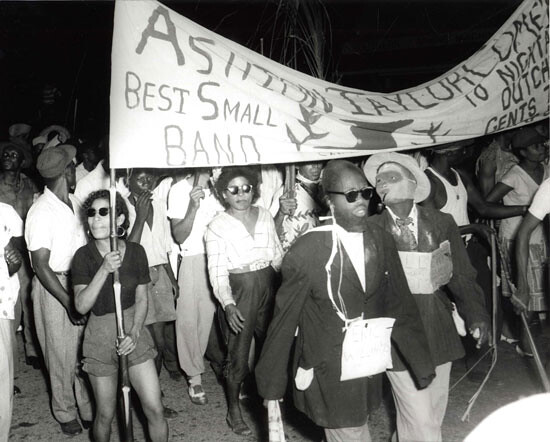

Carnival was widely practiced in the Americas, where colonization and slavery replaced European feudalism and servitude, and where plantations afforded experiments with capitalism that would later develop into British industrialism. In the Old World as in the New, Carnival thrived off the extreme disparity between masters, their subjects, or slaves—what today we would call wealth inequality. Role reversals alleviated a brutally divisive social system by crowning servants and slaves king for a day. Carnival created an opportunity for society to cohere anew, at least for the duration of the festivities.
With this understanding of the structural dynamic of Carnival, it is not surprising to see carnivalesque strands appearing in America’s frayed social fabric at a time when the rich have never been richer and the poor never poorer. Just as for Graeber the current debt crisis is part of a larger story, so is OWS’s carnival. As Graeber explains, “Throughout history, debt has served as a way for states to control their subjects and extract resources from them (usually to finance wars). And when enough people got in enough debt, there was usually some kind of revolt.”15 It is in this sense that capital and Carnival are opposite sides of the same coin, telling the same story from economic and cultural perspectives, respectively. Carnival isn’t merely a cultural practice recuperated by the global anarchist movement and instrumentalized as carnivalesque during protests. It harks back to ancient human archetypes in calling for a reversal of the status quo as a means to mediate between opposite ends of the social spectrum and to create a shared, if fleeting, space to live side by side—a sort of Foucauldian heterotopia, or lived utopia.
In stalwart carnival countries, the century-old festival has failed in recent decades to generate political momentum around key societal issues. Instead, it has succumbed to forms of rampant consumerism and escapist fun that are as remote from political relevance as any other mainstream entertainment. And yet, despite these cautionary tales, carnival countries and cities offer alternatives to mainstream economic and cultural life that are worth examining.
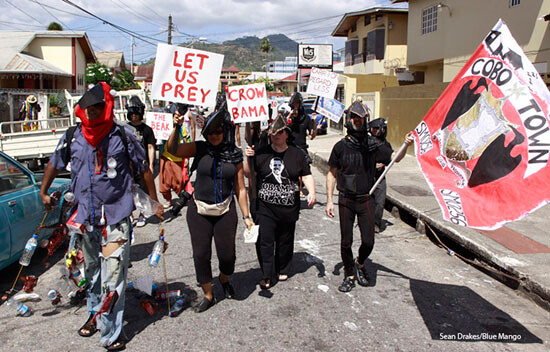

In Trinidad and Tobago, which has a longstanding history of rebellion at Carnival time, beaded bikinis made in China sell for up to $2,500 each, turning exotic bodies into tourist commodities. The “ole mas” tradition, which, much like the Occupy movement, included cardboard placards adorned with political slogans, once offered a healthy public forum for political commentary, but is now largely extinct (challenging one occupier’s belief that “My Cardboard Can Beat Your Billboard”). Only a small enclave of artists keeps the ole mas tradition alive. In the mid-1980s, Peter Minshall’s Rat Race mas band took Port of Spain by storm with its army of masqueraders dressed as rodents holding speech bubbles admonishing greed, gossip, and gullibility in the local vernacular.16 In a DIY style similar to the vanishing Carnival tradition as it could still be observed in 2005, artists Ashraph Richard Ramsaran and Shalini Seereeram created T’in Cow Fat Cow (2009) and Cobo Town (2010).17 These pieces consisted of hand-lettered placards and flags bearing puns about government corruption and public complicity, such as “The People Must be Herd” and “Let us Prey.”18
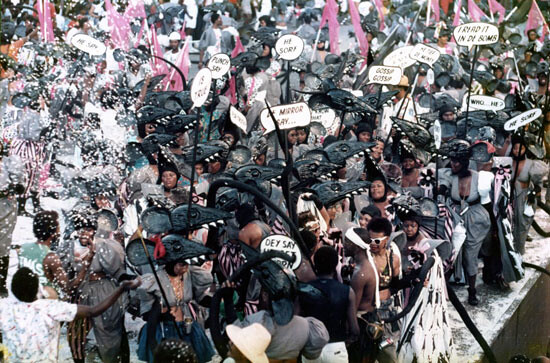

It may come as no surprise that the slow commodification and diminishing criticality of the Trinidad Carnival was initiated by the father of the independent nation. Eric Williams founded the People’s National Movement in 1956 and became the first Prime Minister of independent Trinidad and Tobago in 1962. (Before entering politics he was a professor at Howard University and the author of the landmark historical study Capitalism and Slavery [1944], a work so scathing in its critique of the humanitarian view of British abolitionists that it was not published in the UK until 1964. However, Williams omitted to discuss Carnival as the missing link between Capitalism and Slavery. As Prime Minister, Williams sought to control Carnival through the seemingly auspicious Carnival Development Committee, which attempted to censor calypsonians’s tongue-in-cheek attacks on an often tyrannical political process. Recent developments in Trinidad and Tobago confirm the suspicions of those who believe Carnival to be a tool used by the elite to keep the masses in shackles. In late August, the government imposed a state of emergency in connection with its constitutionally questionable anti-drug security campaign19. So far, the population has shown little interest in protesting to maintain its civil liberties. Will bottled-up grievances explode at the next carnival, or will they dissolve in commercialized fun?
Prior to independence, Trinidadians migrated en masse to the United States and the UK. In their adopted countries, they revived the resistant ethos of the Trinidad Carnival. In New York City, they organized Carnival in Harlem in the mid-1940s then in Brooklyn in the early 1960s. It has become the West Indian American Day Parade, better known as the Brooklyn Labor Day parade. These were fundamentally political gestures aimed at gaining recognition and staking claim to territory in a new homeland. In London, Marxist–feminist Claudia Jones organized the Notting Hill Carnival in 1959 in an effort to quell the wave of white-on-black racism that had culminated in race riots the previous year.
Carnivalesque Goals? Black Carnival, White Carnivalesque
But neither in New York nor in London have black carnivals (as carried out in Trinidad or Brooklyn) and white carnivalesque (as performed in global protest movements) formed a lasting radical alliance that could combat the economic exploitation suffered by working class communities of color and, increasingly, the white middle class. Perhaps OWS will be the opportunity for such an alliance. Meanwhile, this lack of solidarity (reflected by the lack of diversity in protest movements) was addressed by cultural theorist Greg Tate with some measure of controversy. In characteristically colorful language, Tate wrote a radical rant titled “Top 10 Reasons Why So Few Black Folk Appear Down to Occupy Wall Street,” which was first circulated on Facebook and then published in the Village Voice on October 19. Many of Tate’s reasons should be well taken, in particular: “Radical Love Theory,” about how the absence of blacks at OWS has spared the movement more police harassment; “Late Pass Theory,” about blacks’ avoidance of unnecessary police scrutiny; and “The Prison Industrial Complex Crickets Theory,” about the demographic castration of would-be black OWS-ers who are currently incarcerated.20
However, like some white commentators, Tate also takes a jab at the carnivalesque: “As we all know, real thugs don’t do demos or entertain police assault for abstract carnivalesque goals.” This leaves much to be desired in terms of what a greater understanding of the carnival tradition could bring to the movement. (Admittedly, Tate was probably not referring to Carnival at all, as is often the case when using the word “carnivalesque.”) Ironically, Tate’s writing style displays its own carnivalesque sensibility. In a sort of noir grotesque realism, Tate resorts to a raced Rabelaisian semantic field through the use of reappropriated racial slurs like “Negroes,” “Niggas,” “Niggerization,” and “Niggerdom.” He also uses racy expressions such as “bootylicious,” “muhfuhkuhs,” “shit,” “asswhuppings,” “grownass,” and “clusterfuck.” These expressions are made up of words—booty, fuck, shit, ass—that exemplify what Bakhtin called the “material bodily lower stratum.” But Tate can hardly be blamed for missing the carnival point even as he uses carnivalesque language, since in the US this language is more closely associated with America’s own brand of racial carnivalesque, from minstrelsy to blaxpoitation and hip hop. (It is worth noting that American minstrelsy shaped an actual carnival in the early twentieth century, namely, the Cape Town Carnival in South Africa, which was formerly known as the Coon Carnival.)
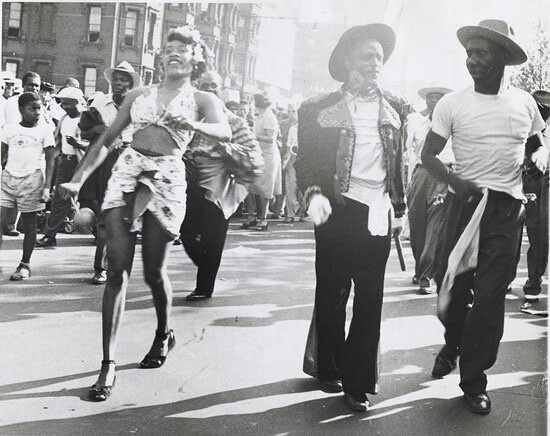

Washington-born Tate would not have had the chance to see the Harlem Carnival, which was gone by the early 1960s. And its Brooklyn successor, much like its Notting Hill counterpart, is no longer at the forefront of radical strategies (anti-racist or otherwise) having been tamed by too much government planning and touristic development. More generally, the dismissal of “abstract carnivalesque goals” may evince the legacy of the rift that once separated Caribbean immigrants and African-Americans. During segregation, Caribbean immigrants, having been educated in the British public school system, were favored for the few jobs available to blacks. This divide-and-conquer strategy prevented unity within the US’s African-descended population. One of the alleged reasons why the Harlem Carnival lost its parade permit was because of a bottle-throwing incident between Caribbean and African-American participants.21
Around the time Tate’s statement was published, Occupy the Hood and Occupy Harlem emerged, urging people of color to participate in the movement. In Manhattan, Occupy offshoots advanced their own agendas through direct action in Downtown/Uptown alliances. And at least two interventions have used modes of public address associated with both the civil rights movement—to which both African-Americans and West Indians contributed—and Carnival—an historically Caribbean mode of rebellion.
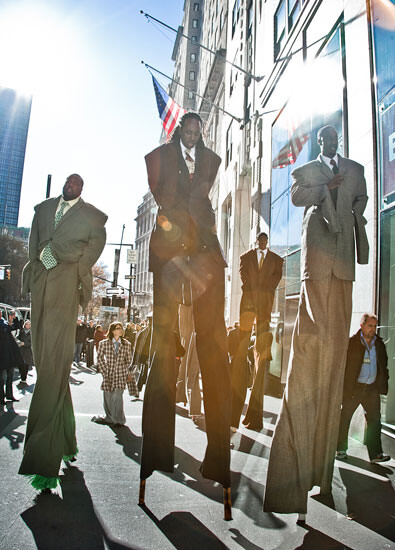

On November 18, artist Laura Anderson Barbata led the Brooklyn Jumbies in a performance of Intervention: Wall Street in Manhattan’s Financial District.22 As their name suggests, the Jumbies come from Brooklyn, where most Caribbean New Yorkers live. According to a press release posted on Facebook, the goal of the event was to “ward off evil and change the mindset of those causing misfortune.”23 In the tradition of West African Moko Jumbie, stilt-walkers embodying spirits were called upon for spiritual cleansing. Moko Jumbies have roots in the Black Atlantic world, from Trinidad and Tobago to Brooklyn, where they incorporate carnival celebrations while retaining distinct spiritual rituals. Barbata, who is from Mexico and divides her time between Manhattan and Mexico City, designed business suits (“reminiscent of David Byrne’s Stop Making Sense big suit”) for the 12-foot-tall jumbies, whose towering height was both suggestive of the Financial District’s skyscrapers and symbolic of Wall Street’s monumental rule over the country.24 Barbata started work on this largely self-funded project in 2008 but was finally spurred to carry out the intervention by the auspicious emergence of OWS. She said that the intervention and her work overall are more about “outreach” and “building cross-cultural bridges” than they are about “spectacle.”25
Will the precedent set by this carnivalesque détournement encourage more Caribbean-Americans to participate in the movement? This is by no means to imply an essentialist view of Caribbean people, according to which Carnival is their sole or even main mode of protest. It is, however, to recognize that much like freedom songs rooted the civil rights movement, so does Carnival root the Caribbean protest tradition.26 One Brooklynite of Caribbean descent, City Councilmember Jumaane D. Williams, has been an outspoken supporter of OWS. He has been arrested at least twice, most recently during the November 17 sit-in at the entrance to the Brooklyn Bridge (fellow councilmember Ydanis Rodriguez was also arrested that day). Prior to OWS, Williams’s last high-profile encounter with police came on September 5, when he was handcuffed and briefly detained … at the West Indian-American Parade.27
Two days after the intervention by the Brooklyn Jumbies, the newly formed Council of Elders, an “independent group of leaders from many of the defining American social justice movements of the twentieth century,” announced an alliance of “basic solidarity” with OWS.28 Time will tell if this gesture of inter-generational and cross-racial unity will spur more civil rights leaders of color into action, and if the movement’s non-violent modus operandi will prevail over police provocation. For the time being, the example set by the Council of Elders seems to have sparked the imagination of mainly white activists, as writer and cultural historian Sharifa Rhodes-Pitts remarked—with the remark not meant to indict said activists as much as to exhort those missing in action.29 Following the passing of “the torch of hope and social justice” from the Elders to OWS during an interfaith service at Liberty Plaza and a public discussion about “space, liberation, and race” at Judson Memorial Church, organizers and participants set out on a candlelight vigil march from Washington Square Park to Duarte Park.


The march was organized by the interfaith clergy group Occupy Faith NYC, the Council of Elders, and various OWS-affiliated arts and culture groups such as Not an Alternative.30 In addition to candles, marchers carried so-called mili-tents to symbolize occupation, and their destination prefigured a possible future occupation. Despite the military language of deployment and invasion the artists-activists used when discussing the dissemination of the mili-tents, these and other artistic interventions that surfaced on N17—such as the black-and-yellow banners and placards (the latter doubling up as shields)—were not meant to encourage confrontation with the police. On the contrary, their purpose was to divert attention away from the overwhelming media focus on clashes between occupiers and the NYPD. These interventions, more recently carried out with tape, sought to dislocate the power of authority over space by appropriating and subverting the colors of official spatial signage. The mili-tents, which were held up with sticks, also recalled the umbrellas of New Orleans second-liners, that other protest-prone carnival-inflected American tradition.
Social Aid and Pleasure: Second Liners and Mardi Gras Indians, Geopsychics and Surregionalists
Perhaps nobody can say whether more blacks and other minorities will rally to the movement in significant numbers. Besides, as Colorlines editor Rinku Sen put it, “the question is not if you can bring people of color to the party but if they can change the music.”31 But given OWS’s underlying anarchist ideology, might not the question as to “why so few black folks appear down at OWS” be more productively phrased as, “where are the black anarchists?” In New Orleans in the late 1970s, Eric Bookhardt and John Clark, two former Louisiana activists from the Vietnam War–era counterculture, came close to circumventing the vexing disappearance of that rare species, the black anarchist: they invented one.
Earlier in the decade, Bookhardt (now an art critic and practicing Buddhist) and Clark (a philosophy professor and self-identified anarchist) were colleagues at the University of New Orleans, where they combined situationist-inflected anarchism with New Orleans’s own homegrown brand of anarchism: Carnival, or as it’s known in the local language, Mardi Gras. In an email to this author, Bookhardt wrote: “Carnival almost always is an innately anarchic and psychodramatic event … that enables everyone to visualize how things can be different and make them different, at least for a day, and that in itself is an inherently valuable, liberating, and potentially revolutionary practice.” He continued: “Carnival was the earliest TAZ prototype because the ‘king’ was always a parody and people’s roles within society were always autonomously self-defined, at least for that day.”32
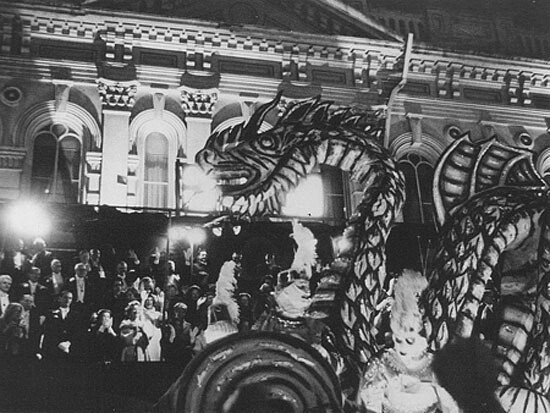

In 1979, Bookhardt published the first edition of Geopsychic Wonders, an illustrated book celebrating the Crescent City’s idiosyncratic urban landscape. The book sparked a cult following among generations of New Orleans artists. Sharing startling similarities with the situationists’ psychogeography, whose key words it inverts, geopsychics is a tribute to New Orleans’s fertile anarcho-situationist soil.
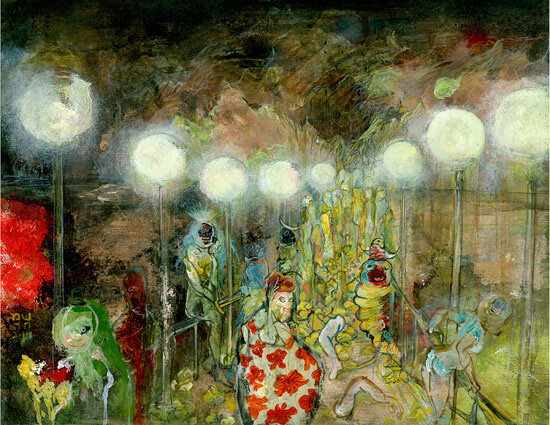

Some artists who practice geopsychics, like the painter Myrtle Van Damitz III, have been involved in both Mardi Gras krewes and local Occupy events. In her work, Van Damitz III renders in oneiric hues the kind of transmogrified creatures seen in the waking dream that is Mardi Gras. An occasional member of Krewe of Eris, “technically the Goddess of Discord parade,” and Krewe of Poux (“lice” in French), Van Damitz III took part in Occupy Frankie and Johnnie’s on October 21. This was the occupation of a local furniture store threatened with corporate takeover by CVS. The store is located in the St. Claude corridor, the site of New Orleans’s latest artist colony and a neighborhood increasingly subject to gentrification.33 But as Van Damitz III clarified, Occupy Frankie and Johnnie’s “was more a farce of Occupy, and a statement about the continuity of free expression and humor in New Orleans to make a statement and effect change.”34 Precisely to the point!
The decadent disguises of Krewe of Eris make Occupy Halloween’s cardboard costumes look rudimentary, while Occupy Frankie and Johnnie’s so-called costumed malcontents—including artist Skylar Fein running around in a fake CVS lab coat while carrying a syringe and a wad of money—are seen as an advantage that Occupy New Orleans has over other Occupy movements. Whether or not this is true, the Mardi Gras tradition has galvanized New Orleans radicals around issues like gentrification and corporatization, which are harshly criticized on such local blogs as Nola Anarcha.35
Under the pseudonym Max Cafard (“cockroach” in French), Clark wrote the Surre(gion)alist Manifesto, which cast into words Louisiana’s Creole anarchism.36 Bookhardt created the founding figure of surre(gion)alism, Lafcadio Bocage (an Afro-Creole), whom he describes as such: “He was also a poet as well as a philosopher, and his anarchism had its roots in his observations of nature and in his contacts with indigenous Louisiana Indians who, in good years, excelled at a lifestyle of purposeful leisure.” Knowing the life and legacy of New Orleans’s free people of color, one can easily imagine Lafcadio Bocage as a forbearer of the Mardi Gras Indian tradition.
According to Van Damitz III, participants in Occupy New Orleans and Occupy Frankie and Johnnie’s are mostly white, as are the Eris and Poux krewes.37 The Mardi Gras Indians and the related Social Aid and Pleasure Clubs are mostly black. These latter groups first emerged in the early nineteenth century among New Orleans’s slaves and free people of color, as well as among the city’s mixed native Indian communities, to which the Mardi Gras Indians trace their roots. On rare occasions, white and black carnival traditions converge, as was the case on October 22 when 6t’9, a white Social Aid and Pleasure Club, invited Mardi Gras Indian Big Chief Fi-Yi-Yi and his gang to participate in their Halloween parade. But for the most part, these traditions remain separate. (One major exception is the carefully choreographed dance of Rex, an old-line [white] krewe, and Zulu, the first black krewe allowed on the official Mardi Gras parade route.) In fact, as musician and historian Bruce “Sunpie” Barnes puts it, the Mardi Gras Indian tradition “built off of a history of resistance to old laws that prevented blacks from masking during Carnival.”
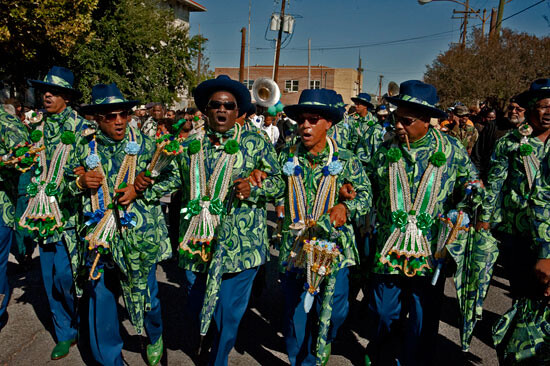

In New Orleans, Mardi Gras remains an exercise in subtle segregation. The fact that there are not floats to give Occupy New Orleans any traction might confirm, as in Trinidad, the safety valve theory of Carnival. Occupy New Orleans officially started on October 6 and has drawn relatively few participants thus far, although Brendan McCarthy of The Times-Picayunes wrote that one of their demonstrations “had a second-line feel to it.”38 But then, just like West Indians played an important part in civil rights movements—most famously, Trinidad-born Black Panther Stokely Carmichael, aka Kwame Ture—so did Louisianans, including Black Panther co-founder Huey P. Newton, leader Geronimo Ji-Jaga, and Justice Minister Jamil Abdullah Al-Amin.39 Though there was hardly anything in the tactics of the Black Panthers recalling a New Orleans culture of celebration, the connection between black carnival organizations and black political activism is well established. According to New Orleans historian Ned Sublette, second lines “are in effect a civil rights demonstration … demonstrating the civil right of the community to assemble in the street for peaceful purposes. Or, more simply, demonstrating the civil right of the community to exist.”40 Indeed, in the afternoon of Saturday, October 29, veteran activist Jerome Smith was not demonstrating with Occupy New Orleans. Instead, he was in the annual second line parade of the Black Men of Labor Social Aid and Pleasure Club, along with Mardi Gras Indian Big Chief Fi-Yi-Yi. In speeches prior to the parade, the Black Men of Labor paid homage to Freedom Riders and members of New Orleans’ Congress of Racial Equality (CORE) chapter. Says Bookhardt,
Mardi Gras Indians are, to my mind, anarchist analogs in the sense that they are self-organizing and non-programmatic expressions of an intuitive ethno-flâneur sensibility. The route is a dérive and they are expressions of geopsychics and psychogeography, and as such they are intuitive native situationists. Anarchists without portfolio. A perfect expression of Nola’s innately anarchistic culture of celebration.
Can the black anarchists be found in New Orleans? If a black radical is a jailed radical at best and a dead radical at worst (there are still several Black Panthers in decade-long solitary confinement at the Louisiana State Penitentiary in Angola, Louisiana), non-confrontational carnival tactics might offer a necessary outlet for otherwise radical practices. More fundamentally, the mutual aid systems under which such practices thrive have been honed for centuries in New Orleans, ensuring the city’s survival. Basic survival is a radical proposition in the face of post-Katrina disaster capitalism (see Naomi Klein) and gentrification-fueled ethnic cleansing (Flaherty), which force blacks out of the city. As Van Damitz III summarizes, “There’s a lot more self-determination and group harmony in a carnival society.”
As the white middle-class is driven out of their homes, campuses, and banks, they are realizing that the social contract no longer works for them, something blacks have felt for a long time. At this juncture, it might be critical that black carnival and white carnivalesque join forces against capital.41
Carnivalesque Protest Sensibility
Scholars Peter Stallybrass and Allon White argue that “it actually makes little sense to fight out the issue of whether or not carnivals are intrinsically radical or conservative.”42 They assert that “there is no a priori revolutionary vector to carnival.” However, at the beginning of OWS, both skeptical journalists and committed protesters made direct references to the mother of revolutions, the French Revolution. The former mocked the protesters’ disappointment that “the Bastille hadn’t been stormed” (only to later ponder, “Carnival or Revolution?”).43 The latter warned in a “memo to the 1%”: “The 99% are waking up. Be nervous. Be Very Nervous. Marie-Antoinette wasn’t.” This followed Roseanne Barr’s call for the return of the guillotine in a speech at Liberty Plaza. This revolutionary chorus, was met with an anthropophagic crowd menacing that “One day, the Poor Will Have Nothing Left to Eat but the Rich” (or the short version: “Hungry? Eat a Banker.”)
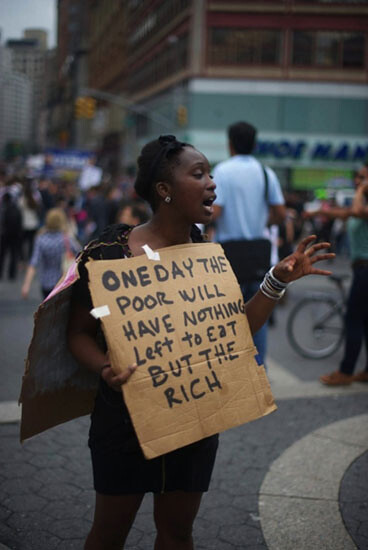

What is at stake here is not so much whether the carnivalesque is turning OWS into a revolutionary movement. Rather, what matters is the bringing to light, through carnivalesque ritual strategy and hierarchy inversion, of the expanse (and expense) of the gap between the 1% and the 99%, and the diversity and disparity within the 99%. As much a site of resistance as a relational mode, the carnivalesque occupation of Wall Street is a symbolic struggle to break the high-low binarism that has besieged contemporary American society, whether in class or race.
Beyond symbolism, what is the likely agency and outcome of this proto-carnivalesque protest? London’s decade-old Carnival Against Capitalism provides some indication. It set the stage for The Battle of Seattle, the World Social Forum, and other counter-summits. It also enabled the tactical media technology behind Indymedia and prefigured the current globalization of grass-roots anti-capitalist movements.44
One cannot help but hope that in New York and the other cities where the movement has taken hold, the carnival cosmology will supplant the exchange economy, as it has in Mardi Gras, allowing for a renewal of the senses atrophied by dematerialized financial transactions. But the real reversal of this carnival might well lie elsewhere, outside the United States. The Arab World is the movement’s proclaimed source of inspiration, having set the tone for this century’s worldwide wave of societal change. From this perspective, American citizens might be looking a lot more like 99% of the rest of the world population, no longer in the privileged top 1%.
This inversion of the world order would also help break that other binary, the one between Western and Arab worlds. It may also resist related reciprocal terrorism in which the body, as in Carnival, is the weapon. In response to Rahul Rao’s question about what “protest sensibility” might befit a world in which there is not one single locus of threat, these protests show that it might well be in the all-encompassing and chaotic carnivalesque. Rao posed this question in the introduction to his book Third World Protest: Between Home and the World (2010). He was responding to Michael Hardt and Antonio Negri’s assertion in Empire (2000) that “the first question of political philosophy today is not if or even why there will be resistance and rebellion but rather how to determine the enemy against which to rebel.”45 In their follow-up volume, Multitude, Hardt and Negri included a section titled “Carnival and Movement,” which was devoted to “protests that are carnevalesque, however, not only in their atmosphere [but] also in their organization.” They credited Bakhtin for “help[ing] us understand … the logic of the multitude, a theory of organization based on the freedom of singularities that converge in the production of the common.”46


Staging their carnival in the middle of a severe economic downturn—the twenty-first century form of Lent—the Wall Street occupiers might seem to want to have their cake and eat it too. For Bakhtin following Rabelais, the essence of carnivalesque celebration was “a feast for the whole world” in which oxen were slaughtered and shared among the citizenry, a form of wealth redistribution.47 So beware: the Wall Street bull may end up like the fattened ox of Mardi Gras, sacrificed this coming Fat Tuesday, or the next Black Wednesday.
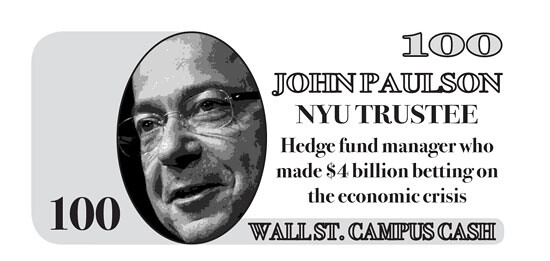

Postscript: I originally wrote this closing metaphor on October 12. Only a month later, it came to life. On N17, a purple-and-golden bull-shaped piñata named Wally, “the spirit of Wall Street at NYU,” was castrated in front of New York University’s Stern School of Business. Wally was created by NYU4OWS, a group of artists and NYU students led by Daniel Aldana Cohen, a PhD student in sociology, with funds from the New York General Assembly’s Arts and Culture Committee. After being castrated, Wally was bashed open by the student body, aka the 99%. From its bulging belly fell “Wall Street Campus Cash,” fake banknotes featuring pictures and financial data about NYU President John Sexton (“Earns $1.6 million a year”), NYU Trustee John Paulson (“Hedge fund manager who made $4 billion betting on the economic crisis”), and others. The bullfight fulfilled the protester’s desire to “destroy the symbols of [the 1%’s] power with a smile.”48 Let’s hope that more such prophecies will soon be realized, more ancient rituals reenacted, and new rituals invented as part of what Jack Santino, in reference to the carnivalesque, termed “the ritualesque.” Traditionally associated with Mexico, the piñata is commonly known to have come from Spain and become part of Lenten celebrations. It is also said to have had Chinese origins, where it was part of New Year festivities and represented … a cow or an ox.
Pearl Duncan, “Police Nabs Wall Street Protesters w 1845 Law Banning Masks,” newyork.nearsay.com, September 20, 2011.
In email correspondence with the author on November 25, 2011. Kira Ackerman is an artist and writer based in New Orleans. She has contributed opinion pieces about Occupy Nola to The Lens. See →.
Information about The Language Experiment was obtained by the author in email and Facebook conversations with Peter Rostovsky on November 25, 2011.
For a sample of the sobriquets given both the 1% and the 99% and the evolving coverage of OWS by New York Times columnists, see: Nicholas D. Kristof, “The Bankers and the Revolutionaries,” New York Times, October 1, 2011. See →. Paul Krugman, “Confronting the Malefactors,” New York Times, October 6, 2011. See →. Paul Krugman, “Panic of the Plutocrats,” New York Times, October 9, 2011. See →. David Brooks, “The Milquetoast Radicals,” New York Times, October 10, 2011. See →.
Raoul Vaneigem, The Revolution of Everyday Life (1963), 105. Retrieved on May 14, 2009 from →.
Hakim Bey (Peter Lamborn Wilson), The Temporary Autonomous Zone (New York: Autonomedia, 1991 (1985)). See →.
Aaron Gell, “Occupy Wall Street and the Poetry of Now-Time,” New York Observer, October 21, 2011. See →.
The Invisible Committee, The Coming Insurrection (Los Angeles: Semiotext(e), 2009).
Gavin Grindon, “Carnival Against Capital: A Comparison of Bakhtin, Vaneigem, and Bey,” Anarchist Studies 12:2 (2004): 148. See →.
For a TV broadcast of Stéphane Hessel’s riveting exposition of his convictions, see →.
William Yardley, “The Branding of the Occupy Movement,” New York Times, November 27, 2011. See →.
For the announcement of the People’s Trial see →.
Bennett, ibid.
Claire Tancons, “The Greatest Free Show on Earth: Carnival from Trinidad to Brazil, Cape Town to New Orleans,” Prospect.1 New Orleans, ed. Dan Cameron (Brooklyn: PICTUREBOX, 2009), 60–61. See →.
Claire Tancons, “Spring,” The 7th Gwangju Biennale. Annual Report: A Year in Exhibitions, ed. Okwui Enwezor (Gwangju: The Gwangju Biennale Foundation, 2008), 337. See →.
Nicholas Laughlin, “That is mas,” Rockstone and Bootheel, Contemporary West Indian Art, eds. Yona Backer and Kristina Newman-Scott (Hartford, CT: Real Art Ways, 2010), 22–27. See →.
To read Prime Minister Kamla Persad-Bissessar’s statement on the state of emergency in Trinidad and Tobago,’ see →.
Greg Tate, “Top 10 Reasons Why So Few Blackfolk Appear Down to Occupy Wall Street,” Village Voice, October 19, 2011. See →.
Philip Kasinitz, “New York Equalizes You? Change and Continuity in Brooklyn’s Labor Day Carnival,” Carnival: Culture in Action—The Trinidad Experience, ed. Milla Riggio (New York and London: Routledge, 2004), 273.
The founders of the Brooklyn Jumbies are Najja Codrington, of Bajan and Senegalese descent, and Ali Sylvester, of Trinidadian descent. Barbata has been collaborating with the Brooklyn Jumbies and other stilt-walker groups in Trinidad and Mexico for nearly a decade.
See →.
As emphasized in this YouTube video →.
Email conversation with the author, November 21, 2011.
See “Singing Civil Rights” in T.V. Reed, The Art of Protest: Culture and Activism from the Civil Rights Movement to the Streets of Seattle (Minneapolis and London: University of Minnesota Press, 2005), 1-39.
See →.
In conversation with the author in New Orleans on November 22, 2011.
Information about the November 20 event and mili-tent march provided by Jason Jones in Skype conversations with the author on November 23 and 25, with additional contribution from Beka Economopoulos. Both Jones and Economopoulos are members of Not an Alternative.
For Sen’s views on the question, see the Democracy Now! broadcast of the November 25 Occupy Everywhere panel organized by The Nation →.
All quotes from Eric Bookhardt are from emails exchanged with the author during the night of November 2–3, 2011.
“Occupy Stands Up for the Special Man,” Nola Defender, October 21, 2011.
In an email conversation with the author on November 17, 2011.
“The Cult of Convenience—the Mall on St. Claude,” Nola Anarcha, October 12, 2011. See →.
Max Cafard (John Clark), The Surre(gion)alist Manifesto, circa 1989. See →.
Email conversation with the author on October 17, 2011.
Brendan McCarthy, “About 400 marchers join ‘Occupy New Orleans’ protest,” Times-Picayunes, October 6, 2011. See →.
Jordan Flaherty, Floodlines: Community and Resistance from Katrina to the Jena Six (Chicago: Haymarket Books, 2011), 17-18.
Quoted in Flaherty, ibid., 8.
Bennett, ibid.
Peter Stallybrass and Allon White, The Politics and Poetics of Transgression (Ithaca, New York: Cornell University Press), 1986, p.14.
Bellafante, ibid., September 23. Peter Catapano, “Wall Street Protests: Carnival or Revolution? Can you Hear Them Now?” New York Times, September 30, 2011.
For more on the legacy of J18 see Brian Holmes, “Do-it-Yourself Geopolitics: A Map of the World Upside Down,” Spectacle, Pleasure Principle, or the Carnivalesque? A Reader on Possibilities, Experiences of Difference, and Strategies of the Carnivalesque in Cultural/Political Practice, eds. Sønke Gau and Katharina Schlieben (Berlin: b_books Verlag, 2008), 265-73.
Quoted in Rahul Rao, Third World Protest: Between Home and the World (Oxford: Oxford University Press, 2010), 2.
Michael Hardt and Antonio Negri, Multitude (New York: Penguin Press, 2004), 211.
Mikhail Bakhtin, Rabelais and His World, trans. Helene Iswolsky (Bloomington and Indianapolis: Indiana University Press, 1984), 223.
Claire welcomes your comments on this essay at carnivalagainstcapital@gmail.com as she develops it into a book.

